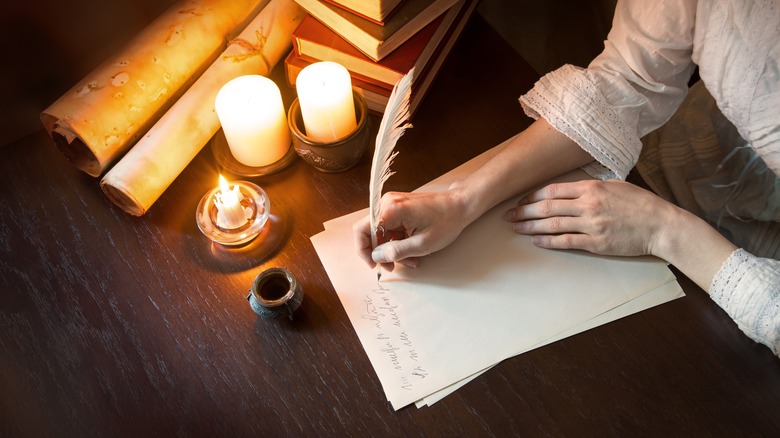This Seemingly-Innocent Love Note From The 1700s Holds A Morbid Secret
The Jacobite Risings of the 1700s were rebellions against the British throne ruled by the Hanoverians. The Jacobites — supporters of the House of Stuart — staged uprisings in 1715, 1719, and 1745 to overthrow the crown (via the National Library of Scotland). Many Jacobites were arrested, including James Radclyffe, the third Earl of Derwentwater.
Radclyffe was born to the second Earl of Derwentwater, Edward Radclyffe, and Lady Mary Tudor, one of Charles II's illegitimate children. As reported by the Northumbrian Jacobite Society, those who knew Radclyffe described him as a kind and charming man who was a staunch supporter of the Jacobites. He married heiress Anna Maria Webb in 1712, and they had their first child, a boy, in 1714, just before the Jacobite rising of 1715. Queen Anne, the last monarch of the House of Stuart, died in 1714, which sparked the rebellion, and she was succeeded by George I from the House of Hanover. Jacobites from Scotland and England joined forces to stage an uprising in different locations, and Radclyffe was one of the key players in the Northumberland uprising. In the 1715 Battle of Preston, the Jacobites were initially victorious, but more government forces were sent to the location, which resulted in the Jacobites eventually surrendering, as noted by Visit Preston.
James Radclyffe's imprisonment and death
James Radclyffe was one of the Jacobites who surrendered in Preston. He was imprisoned at the Tower of London for a time, and efforts were made to have him pardoned but they were futile. He was beheaded for treason on February 24, 1716, when he was just 26 years old. Based on records, as noted by The Past, Radclyffe's wife, Anna Maria, was given her husband's severed head and body after his execution, along with a linen sheet that Radclyffe used on his bed during his stay at the Tower of London.
According to the curator of social history at the Museum of London, Beverley Cook, Anna Maria was able to spend time with his husband during the four months that he was imprisoned. "It would be lovely to think that they were lying together beneath this sheet. Obviously, we can't prove that, but it's likely that she conceived their daughter at that time," Cook stated, per The Guardian. James and Anna Maria seemed to have had a loving marriage. Radclyffe wrote a letter to Anna Maria's parents while in prison wherein he stated that their daughter made him "the happiest of men." In a letter to his wife, he addressed her as his "dearest worldly treasure," per The Northumbrian Jacobite Society.
Anna Maria's note to honor James Radclyffe
To honor his husband's memory, Anna Maria stitched a short love note on the linen sheet that James Radclyffe used in his final days alive. One edge of the sheet has embroidered designs of flowers and a heart-shaped wreath. A short note on one side reads, "The sheet OFF MY dear Lord's Bed in the wretched Tower of London February 1716 x Ann C of Darwent=Waters+" (via The Past). What's interesting, though, is that the love note was embroidered with human hair. As noted by the Museum of London, it is most likely that the hair used was both Anna Maria's and Radclyffe's (taken after he was beheaded), as they have different colors. Beverley Cook also noted that Anna Maria kept a locket that contained a lock of her husband's hair.
According to The Guardian, Anna Maria left England and traveled to Brussels, Belgium with her son and daughter, and that was most likely when she embroidered the note on the sheet. Records indicate that she died in 1723 due to smallpox. "The care and devotion speaks to Anna's personal devastation and remarkable character – determined to protect the memory of her husband long after his death," Cook said. As noted by the London Post, the sheet was passed to Jacobite supporters and activists after Anna Maria's death. It fell into the hands of private collectors later on, and the Museum of London acquired it in 1934.


